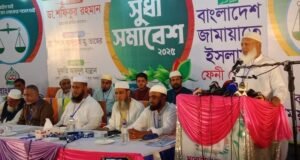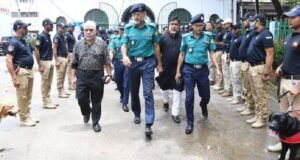
Moksedul, a brick kiln labourer, was given birth to in someone else’s house. His son, too, was welcomed in a house that did not belong to Moksedul. For 30 long years, Mokseful waited for a house that he can call his own. His long-desired wish has been fulfilled at last, after he has been allotted a semi-furnished house under his own name. All modern facilities, including electricity and drinking water, are available in the house. Moksedul is on cloud nine after receiving this gift from Bangladesh Prime Minister Sheikh Hasina. He said he can live very well with his family now.
According to an analysis by India’s leading news magazine INDIA TODAY, sixty-five-year-old Piara Begum is a resident of Patharghata in Barguna, the southernmost town of the country, built on the shores of the Bay of Bengal. Thirty years ago, her family was lost in the river. Afterwards, she would build a house on the bank of the river. After marriage, her husband did not have any property or house and the couple continued to live on the banks of the river. But 16 years ago, her husband died of cancer. As she had no children, Begum was left to her own devices.
Finally, Piara Begum’s misery has come to an end after she is allotted a house built by the Bangladesh government on the occasion of ‘Mujib centenary’ under the ‘Ashrayan’ scheme.
“I have been suffering all my life. I never dreamed of a house. Now, I have got a semi-furnished house with land. The prime minister has given me a house. I am very happy. As long as I live, I will pray for the prime minister,” she told India Today.
The story of Moksedul and Piara Begum finds resonance with lakhs of poor, landless, and homeless people in Bangladesh. Thousands have now found shelter and seen an end to their deprivation under Bangladesh Prime Minister Sheikh Hasina’s initiatives for inclusive development.
ABOUT ASHRAYAN PROJECT
The Ashrayan project is one of the schemes undertaken by Prime Minister Sheikh Hasina to transform Bangladesh into a developed and prosperous country by 2041. Through this project, Sheikh Hasina is aiming for inclusive development by providing houses for landless, homeless, and marginalised people in 64 districts of the country. She declared, “Not a single person will be homeless in Bangladesh.”
According to official sources, since its inception in 1997, around 5,07,244 landless and homeless families have been rehabilitated in various stages through this shelter project. Through this project, the backward community of society has been provided with semi-finished houses along with 2 decimals of land ownership.
Beneficiaries under this scheme are not only provided accommodation, but are also provided various training, daily allowances during training, and loans after training to make them economically self-reliant. The scheme includes empowering women by giving them half ownership of land and houses, providing free electricity connection, providing clean water by installing one shallow tube well for every 10 families, and providing food assistance under three months of VGF to the resettled families initially.
A large number of trees have been planted in the vicinity to make the area under the project livable. Through this, landless, homeless, and displaced people are being established as human resources.
Under the project, rehabilitation has been planned for 2,93,361 families in the first phase and 5,92,261 families in second.
SHEIKH HASINA MODEL OF DEVELOPMENT
The Sheikh Hasina-led government has brought in several initiatives to bring the deprived people of society into the mainstream of development. Additionally, climate refugees, minorities, third gender, beggars, Bede, and other backward communities are also being provided houses with land.
They are being included in the mainstream of economic development by creating opportunities for education, health and employment. ‘Ashrayan Project’ is a unique example of how a house can be a major tool for overall family welfare and social development. This method of inclusive development and poverty alleviation has already come to be known as the “Sheikh Hasina model”.
The features of this model includes becoming economically self-sufficient by increasing earning power and savings; establishing respectable livelihood and social status; empowering women by giving women half ownership of land and houses; developing human resources by increasing skills and capabilities through training; improving the environment through extensive afforestation and tree plantation; ensuring city amenities in villages.
ASHRAYAN PROJECT DURING MUJIB YEAR
Mujib Year was announced for the celebration of the birth centenary of Father of the Nation, Bangabandhu Sheikh Mujibur Rahman. On this occasion, 63,999 families were provided with land ownership in the first phase on January 21, 2021, and 53,330 families were provided with land ownership in the second phase on June 20, 2021. Currently, more than 65,000 more houses are under construction in the third phase. On the occasion of Mujib centenary, Sheikh Hasina’s government provided semi-furnished single houses with land to 1,83,003 families so far.
In order to bring the backward communities of the state into the mainstream, permanent ownership of land is being provided by constructing completely free houses. Examples of low-interest loans for land purchase are found in several countries in the world, but the case of free land ownership with houses is the first in Bangladesh.
ACHIEVING SDGs THROUGH ASHRAYAN
Shelter projects also play a key role in achieving the United Nations Sustainable Development Goals or SDGs. A house would help a family break out of the vicious cycle of poverty. Through these shelter projects, a fragmented family would get access to safe housing, education, health, women’s empowerment, and women’s rights.
Sheikh Hasina’s Innovation Shelter Scheme has been able to bring about positive changes in inclusive development. Through the implementation of the Asharyan Project, Bangladesh has been facilitated in achieving the goals of poverty eradication, hunger eradication, health care, quality education, gender equality and women’s empowerment, clean water and sanitation, decent employment, reducing inequality and sustainable and secure settlements.
 Weekly Bangla Mirror | Bangla Mirror, Bangladeshi news in UK, bangla mirror news
Weekly Bangla Mirror | Bangla Mirror, Bangladeshi news in UK, bangla mirror news







